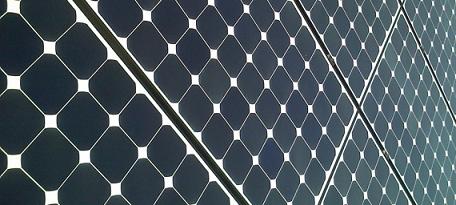Home > Press > Prof researching better solar panels
 |
| (Flickr / CC BY 2.0) |
Abstract:
Nanotechnology could make solar energy a cheap, sustainable option
By Lance Mudryk
Prof researching better solar panels
Alberta, Canada | Posted on May 15th, 2010With his $20,000 research grant, Karthik Shankar intends to develop a more efficient, cheaper solar panel using nanotechnology.
The University of Alberta engineering professor's research is largely based on the increased functionality of solar cells. By implementing nanotechnology into semiconductors — materials used to convert sunlight into electricity — his solar panels will be able to harvest light more intensely and access a wider spectrum of the light given off by the sun.
"A solar cell works by harvesting light and converting it into electricity," Shankar explained. "(We're) using metal nanoparticles which have these so-called plasmonic properties."
According to Shankar, these plasmonic properties make the electromagnetic field of a structure much stronger. This will help the solar cells convert more electricity out of the light they're exposed to.
"When we simulated them, we saw that these nanoparticles have a certain resonance, and at that resonance they really amplify the electromagnetic fields around those particles," he said.
Shankar believes that his proposal could possibly help solar technology take off, largely due to its economic feasibility. By using organic materials, metals, and a semiconductor known as titanium dioxide, costs could be dramatically lowered.
"(What we're proposing is) potentially a lot cheaper than what's out there," he said. "One of the problems that's preventing the eruption of solar technology is that the solar cells, which are made from American silicon, are very expensive. And so they're still not a viable competitor to fossil fuels."
Even though Shankar has been developing this proposal for a year now, he still believes that his idea could take five to 10 years before it will be commercially viable.
"The first objective is to translate these ideas, perform experiments, and actually realize the idea. Later on, if the idea is successful, we'll probably try to commercialize it in a spin-off company or license the intellectual property to a bigger company if they're interested."
####
For more information, please click here
Copyright © University of Alberta
If you have a comment, please Contact us.Issuers of news releases, not 7th Wave, Inc. or Nanotechnology Now, are solely responsible for the accuracy of the content.
| Related News Press |
News and information
![]() Researchers develop molecular qubits that communicate at telecom frequencies October 3rd, 2025
Researchers develop molecular qubits that communicate at telecom frequencies October 3rd, 2025
![]() Next-generation quantum communication October 3rd, 2025
Next-generation quantum communication October 3rd, 2025
![]() "Nanoreactor" cage uses visible light for catalytic and ultra-selective cross-cycloadditions October 3rd, 2025
"Nanoreactor" cage uses visible light for catalytic and ultra-selective cross-cycloadditions October 3rd, 2025
Academic/Education
![]() Rice University launches Rice Synthetic Biology Institute to improve lives January 12th, 2024
Rice University launches Rice Synthetic Biology Institute to improve lives January 12th, 2024
![]() Multi-institution, $4.6 million NSF grant to fund nanotechnology training September 9th, 2022
Multi-institution, $4.6 million NSF grant to fund nanotechnology training September 9th, 2022
Announcements
![]() Rice membrane extracts lithium from brines with greater speed, less waste October 3rd, 2025
Rice membrane extracts lithium from brines with greater speed, less waste October 3rd, 2025
![]() Researchers develop molecular qubits that communicate at telecom frequencies October 3rd, 2025
Researchers develop molecular qubits that communicate at telecom frequencies October 3rd, 2025
![]() Next-generation quantum communication October 3rd, 2025
Next-generation quantum communication October 3rd, 2025
![]() "Nanoreactor" cage uses visible light for catalytic and ultra-selective cross-cycloadditions October 3rd, 2025
"Nanoreactor" cage uses visible light for catalytic and ultra-selective cross-cycloadditions October 3rd, 2025
Energy
![]() Sensors innovations for smart lithium-based batteries: advancements, opportunities, and potential challenges August 8th, 2025
Sensors innovations for smart lithium-based batteries: advancements, opportunities, and potential challenges August 8th, 2025
![]() Simple algorithm paired with standard imaging tool could predict failure in lithium metal batteries August 8th, 2025
Simple algorithm paired with standard imaging tool could predict failure in lithium metal batteries August 8th, 2025
Grants/Sponsored Research/Awards/Scholarships/Gifts/Contests/Honors/Records
![]() Researchers tackle the memory bottleneck stalling quantum computing October 3rd, 2025
Researchers tackle the memory bottleneck stalling quantum computing October 3rd, 2025
![]() New discovery aims to improve the design of microelectronic devices September 13th, 2024
New discovery aims to improve the design of microelectronic devices September 13th, 2024
![]() Physicists unlock the secret of elusive quantum negative entanglement entropy using simple classical hardware August 16th, 2024
Physicists unlock the secret of elusive quantum negative entanglement entropy using simple classical hardware August 16th, 2024
Solar/Photovoltaic
![]() Spinel-type sulfide semiconductors to operate the next-generation LEDs and solar cells For solar-cell absorbers and green-LED source October 3rd, 2025
Spinel-type sulfide semiconductors to operate the next-generation LEDs and solar cells For solar-cell absorbers and green-LED source October 3rd, 2025
![]() KAIST researchers introduce new and improved, next-generation perovskite solar cell November 8th, 2024
KAIST researchers introduce new and improved, next-generation perovskite solar cell November 8th, 2024
![]() Groundbreaking precision in single-molecule optoelectronics August 16th, 2024
Groundbreaking precision in single-molecule optoelectronics August 16th, 2024
![]() Development of zinc oxide nanopagoda array photoelectrode: photoelectrochemical water-splitting hydrogen production January 12th, 2024
Development of zinc oxide nanopagoda array photoelectrode: photoelectrochemical water-splitting hydrogen production January 12th, 2024
|
|
||
|
|
||
| The latest news from around the world, FREE | ||
|
|
||
|
|
||
| Premium Products | ||
|
|
||
|
Only the news you want to read!
Learn More |
||
|
|
||
|
Full-service, expert consulting
Learn More |
||
|
|
||








